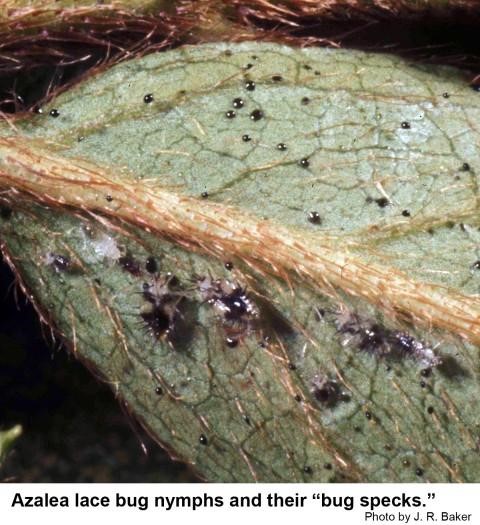Azaleas Looking a Little “Washed Out”?
go.ncsu.edu/readext?867700
en Español / em Português
El inglés es el idioma de control de esta página. En la medida en que haya algún conflicto entre la traducción al inglés y la traducción, el inglés prevalece.
Al hacer clic en el enlace de traducción se activa un servicio de traducción gratuito para convertir la página al español. Al igual que con cualquier traducción por Internet, la conversión no es sensible al contexto y puede que no traduzca el texto en su significado original. NC State Extension no garantiza la exactitud del texto traducido. Por favor, tenga en cuenta que algunas aplicaciones y/o servicios pueden no funcionar como se espera cuando se traducen.
Português
Inglês é o idioma de controle desta página. Na medida que haja algum conflito entre o texto original em Inglês e a tradução, o Inglês prevalece.
Ao clicar no link de tradução, um serviço gratuito de tradução será ativado para converter a página para o Português. Como em qualquer tradução pela internet, a conversão não é sensivel ao contexto e pode não ocorrer a tradução para o significado orginal. O serviço de Extensão da Carolina do Norte (NC State Extension) não garante a exatidão do texto traduzido. Por favor, observe que algumas funções ou serviços podem não funcionar como esperado após a tradução.
English
English is the controlling language of this page. To the extent there is any conflict between the English text and the translation, English controls.
Clicking on the translation link activates a free translation service to convert the page to Spanish. As with any Internet translation, the conversion is not context-sensitive and may not translate the text to its original meaning. NC State Extension does not guarantee the accuracy of the translated text. Please note that some applications and/or services may not function as expected when translated.
Collapse ▲When the azaleas bloom, there can hardly be anything more beautiful in the landscape. Dramatic masses of white, red, and other colors make striking seasonal statements in the landscape, draw hummingbirds, and add value and enjoyment to the home.
But, there is trouble in paradise too. While azaleas would make a seriously poisonous meal for people, a number of species of insects, and lots of deer, seem to see them as a heavenly buffet. In particular, the azaleas lace bug makes its appearance each year, and does everything it can to leave the leaves of your azaleas looking dull, off-color (light tan), stippled, and ugly. Some people call it “washed out”.

There are other problems that mess up a great azalea display, of course, but lace bugs are the most frequently reported insect pest in the landscape! Possibly because the plants generally survive lace bug infestations, and so serve as long term breeding grounds for more lace bugs! There are other disease and insect issues for azaleas, however, lace bug damage has some distinctive characteristics that make it clear that they are at fault. This insect passes the winter as an egg inside the leaf tissue, protected by a drop of excrement that has hardened into a varnish-like shield. These little, hard, black, spots or “shields” are a great give away for the presence of the pest. But they really do protect the eggs from your efforts to kill them directly.

Once you see the “washed-out” look of the azaleas, you do have to put out a little effort to find the pests. The adults, eggs, and nymphs are all found on the undersides of leaves! And what is more, we have at least two generations every year in North Carolina. So a whole new crop of eggs, nymphs and adults can appear more than once a year.
There are some tiny parasitic wasps, and predaceous azalea plant bugs that help out some with these pests, but you still end up with damage to the plant that most find unacceptable.
To face the challenge of control, it is good to start the control when you begin to see them to prevent as much reproduction as possible. There are garden pesticides labeled for control of these pests. Just be sure to follow all label directions. Many of these materials can be hard on beneficial insects in the landscape. On the other hand, Insecticidal soaps and horticultural oils will kill the nymphs and adult lace bugs, but they don’t kill eggs, nor any lace bugs that they do not contact when you apply. Products with Imidacloprid are systemic insecticides that can be applied to the soil surface to kill the lace bugs above. But this must be done in accordance with the research based label directions.
Keep your azalea paradise beautiful, and with nice green leaves! Look out for the washed-out look. Check for lace looking insects and black spots on the bottom of leaves. And make safe, careful treatments, to keep azaleas healthy, happy, and growing more beautiful every year!

For more information on plants and pests, or on classes you can take on gardening, call Tom Dyson at 704-735-8461, or email tom_dyson@ncsu.edu. For general info on Food Science programs, 4-H and youth development, gardening, pests, or farming, go to our webpage for N.C. Cooperative Extension, Lincoln County Center.
By: Tom Dyson
North Carolina Cooperative Extension Director, Lincoln County




